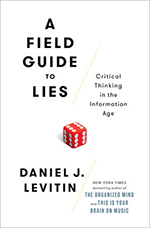 In the library the other day, this book’s title caught my eye. I grabbed it and readily consumed it over the past week. It’s a guide to exercising our best critical thinking skills during a time when our attention is awash in claims both vital and derivative, important and erroneous. How do we tell truth from fiction? Politically, the timing could hardly be more propitious for the release of this volume, but politics is only a very small part of the Field Guide‘s purview. There’s plenty about health and medicine, conspiracy thinking, statistics of risk, and the role of expertise/authority. Levitin lays the book out in three parts: quantitative, qualitative, and the practice of science. It’s clearly written, with plenty of good examples rendered quickly in succession, providing a more robust view of the techniques / ideas under discussion. I appreciated the extended discussion of ways graphics can be manipulated in order to deceive. There’s also a bite-sized primer on formal logical statements and fallacies that result from mangling them. Bayesian probability and how to calculate it also gets a lot of attention, and comes close to being a “theme” that runs through the book. A final section examines four disparate “case studies” where Levitin examines what it makes sense to think or do. Because these case studies are explored in more depth than the examples cited elsewhere in the book, this section has a very different feel to it – it’s not as fast-paced. Overall, I found the book to be a useful read, and would recommend it to anyone who’s not already well versed in critical thinking.
In the library the other day, this book’s title caught my eye. I grabbed it and readily consumed it over the past week. It’s a guide to exercising our best critical thinking skills during a time when our attention is awash in claims both vital and derivative, important and erroneous. How do we tell truth from fiction? Politically, the timing could hardly be more propitious for the release of this volume, but politics is only a very small part of the Field Guide‘s purview. There’s plenty about health and medicine, conspiracy thinking, statistics of risk, and the role of expertise/authority. Levitin lays the book out in three parts: quantitative, qualitative, and the practice of science. It’s clearly written, with plenty of good examples rendered quickly in succession, providing a more robust view of the techniques / ideas under discussion. I appreciated the extended discussion of ways graphics can be manipulated in order to deceive. There’s also a bite-sized primer on formal logical statements and fallacies that result from mangling them. Bayesian probability and how to calculate it also gets a lot of attention, and comes close to being a “theme” that runs through the book. A final section examines four disparate “case studies” where Levitin examines what it makes sense to think or do. Because these case studies are explored in more depth than the examples cited elsewhere in the book, this section has a very different feel to it – it’s not as fast-paced. Overall, I found the book to be a useful read, and would recommend it to anyone who’s not already well versed in critical thinking.

